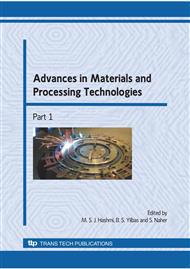p.672
p.680
p.688
p.696
p.704
p.711
p.718
p.725
p.738
An Investigation on Machining Power of EN-AC 48000 Aluminum Alloy Used in Automotive and Aerospace Industries
Abstract:
In this paper, the effect of machining parameters including cutting velocity, feed rate, and tool material on machining power of EN-AC 48000 aluminium alloy has been studied. A L27 Taguchi's standard orthogonal array has been applied as experimental design to investigate the effect of the factors and their interaction. Twenty seven machining tests have been accomplished with two random repetitions, resulting in fifty four experiments. EN-AC 48000 is an important alloy in automotive and aerospace industries. Machining of this alloy is of vital importance due to build-up edge and tool wear. Machining power is an essential parameter affecting the tool life, dimensional accuracy, and cutting efficiency. Three types of cutting tools including coated carbide (CD 1810), uncoated carbide (H10), and polycrystalline diamond (CD10) have been used in this study. Statistical analysis has been employed to study the effect of factors and their interactions using ANOVA analysis. Moreover, optimal factor levels have been presented using signal to noise ratio (S/N) analysis. Also, regression model have been provided to predict the machining power. Finally, the results of confirmation tests have been presented to verify and compare the adequacy of the predictive models.
Info:
Periodical:
Pages:
704-710
Citation:
Online since:
December 2009
Authors:
Price:
Сopyright:
© 2010 Trans Tech Publications Ltd. All Rights Reserved
Share:
Citation:


